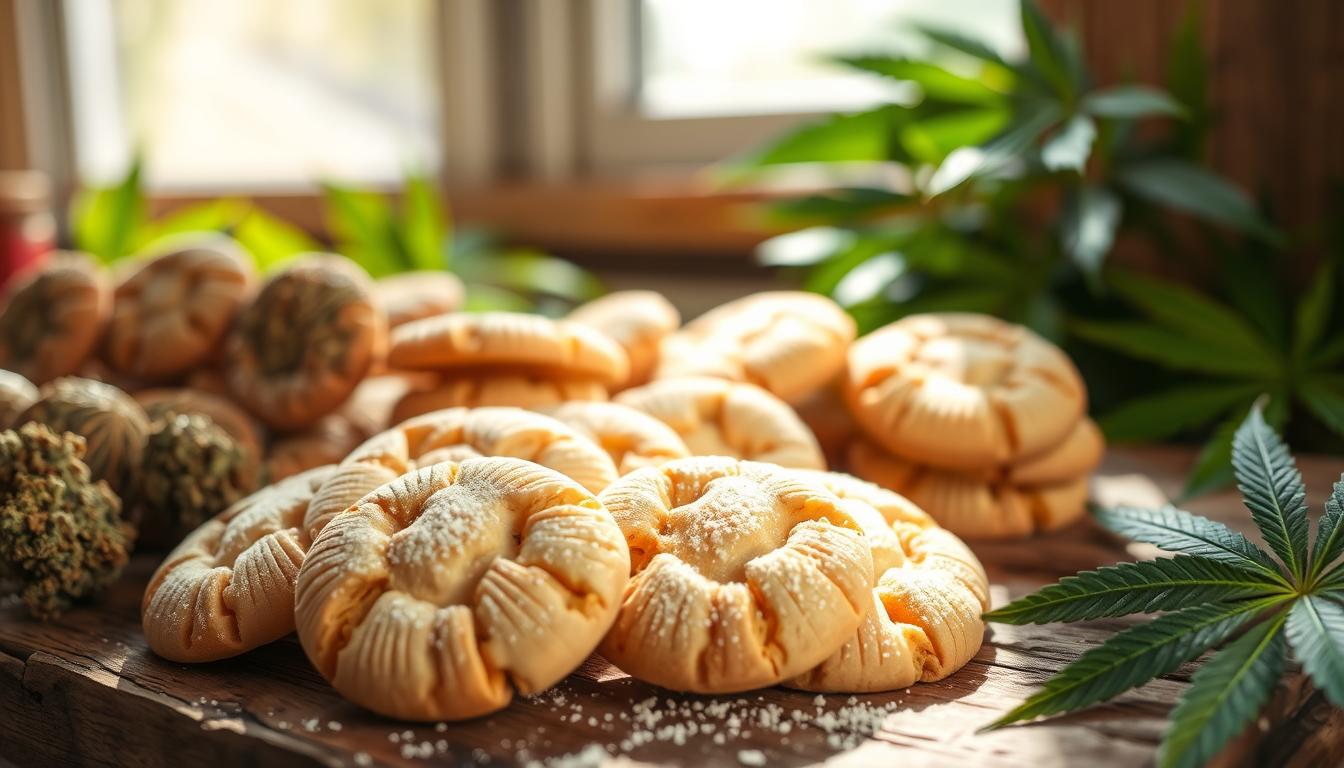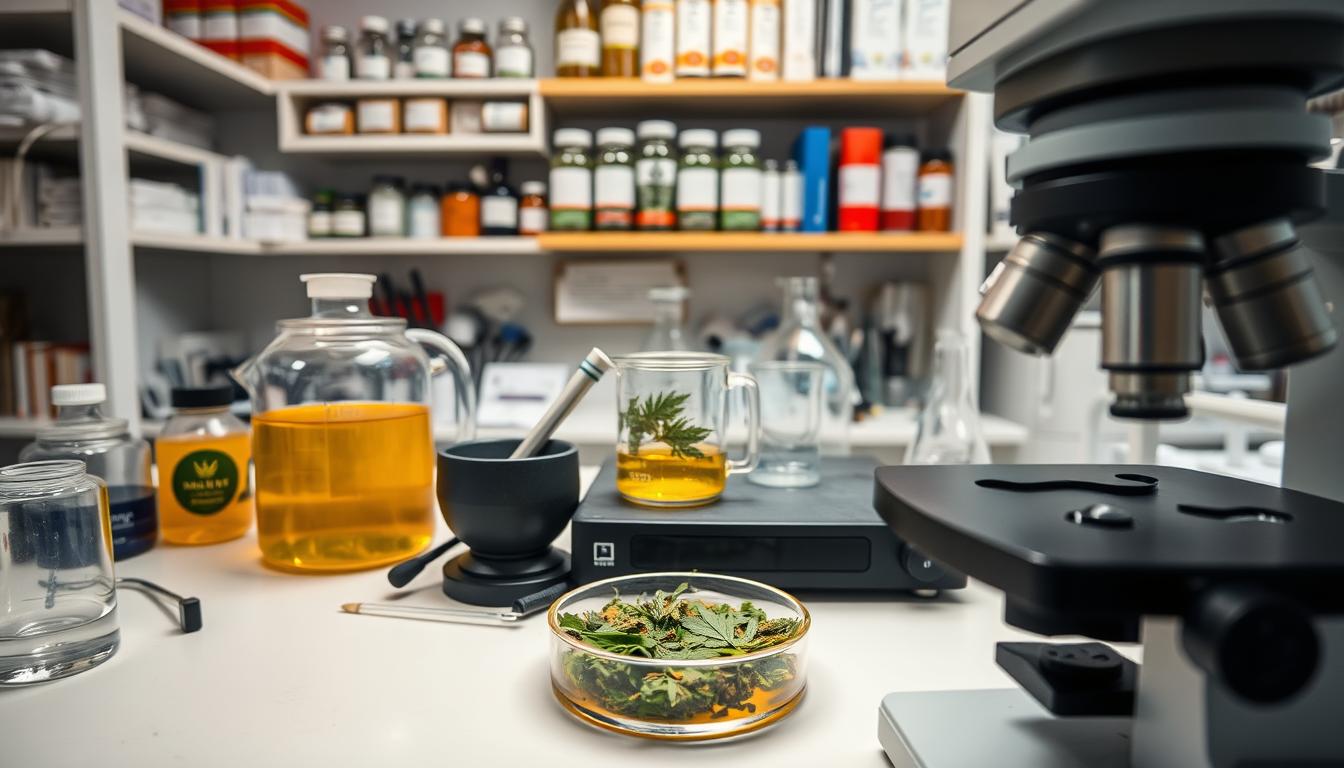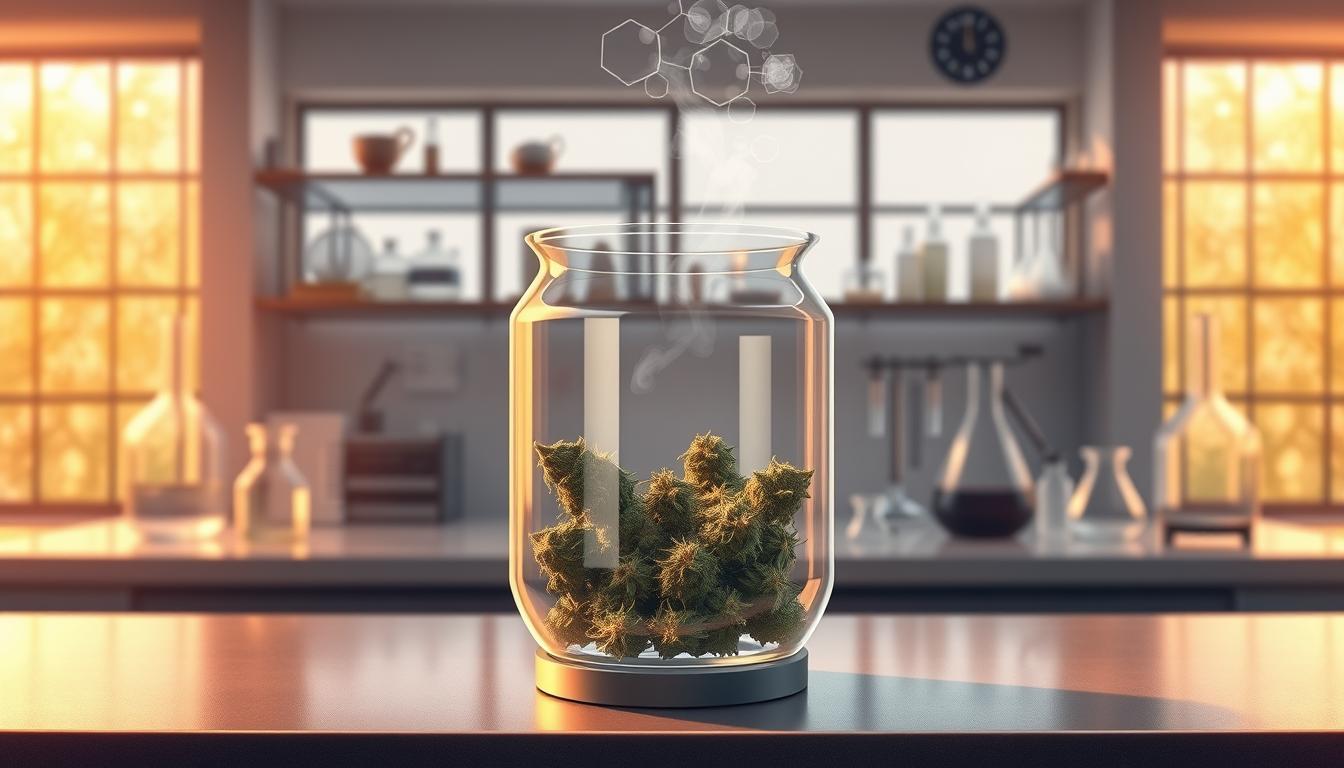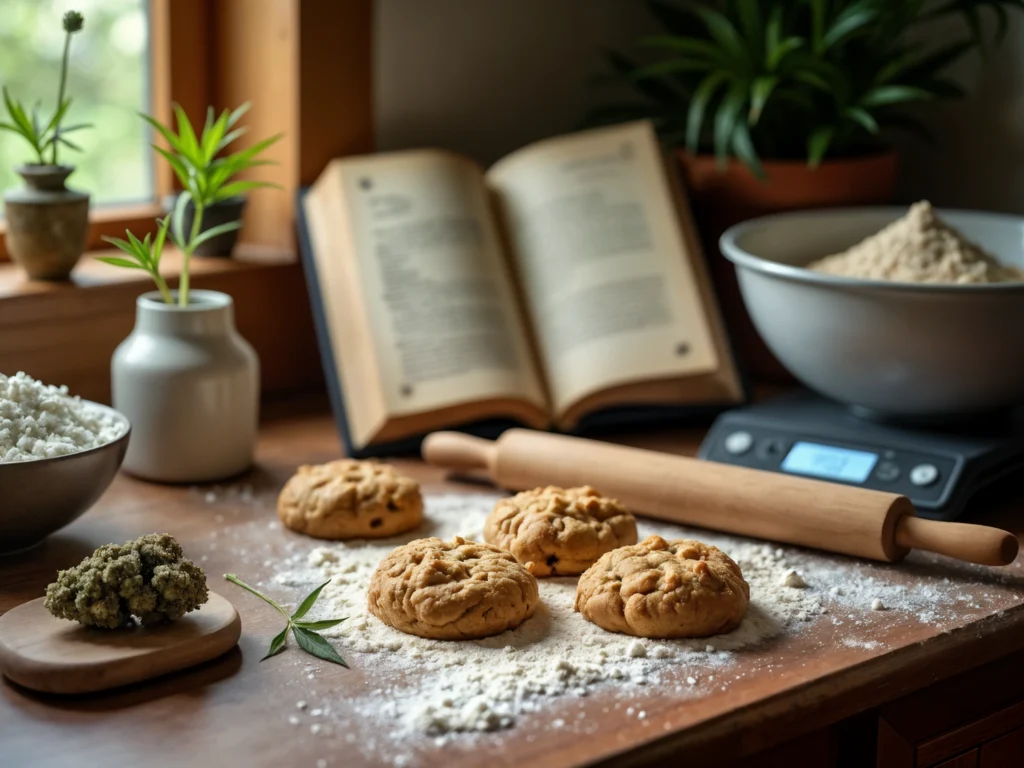Baking with cannabis is now more popular than ever. It lets people enjoy cannabis-infused treats in tasty and private ways. Among these, marijuana cookies are loved for being easy to make and flexible.

To make the best cannabis edibles, you need to know a few things. This article will show you how. It will give you tips and tricks to make sure your marijuana cookies are always perfect.
Key Takeaways
- Understanding the basics of cannabis infusion
- Choosing the right cannabis strain for your edibles
- Tips for achieving the perfect dosage
- Best practices for baking with cannabis
- Common mistakes to avoid when making cannabis edibles
The Science of Cannabis Edibles
Cannabis edibles are getting more popular. But, to understand their effects, we need to look into the science. Unlike smoking, edibles work differently. They go through the digestive system, changing how THC and CBD are absorbed.
How Edibles Affect Your Body Differently Than Smoking
Edibles and smoking have different effects on the body. Edibles are broken down by the liver, making THC stronger. This leads to a more intense and longer-lasting effect. Smoking, by contrast, gives quicker but less intense effects.

Understanding Onset Time and Duration
Edibles take longer to start working, from 30 minutes to 2 hours. This is because they go through digestion. The effects can last 4 to 8 hours, depending on the dose and how fast you metabolize.
The Entourage Effect in Edibles
The entourage effect is when different parts of cannabis work together. In edibles, this effect is more noticeable. The slower digestion lets these compounds interact more, possibly making the experience better.
Essential Ingredients and Equipment
Making tasty and strong marijuana cookies needs the right ingredients and tools. First, pick the best cannabis strain for your treats.
Selecting the Right Cannabis Strain for Baking
The cannabis strain you choose affects your cookies’ taste and effect. Indica strains are great for relaxing, while Sativa strains boost energy. Think about what you want your cookies to do.
“The Cannabis Cookbook” by Chris Boucher says the strain’s terpenes also change the flavor. For example, limonene makes cookies taste like citrus.
Quality Baking Ingredients That Complement Cannabis
Good baking ingredients are key too. Use high-quality chocolate, fresh butter, and pure vanilla extract for better taste. The sugar you pick can also change the cookie’s texture and flavor.
“The quality of your ingredients directly impacts the taste and potency of your edibles.” –
A renowned cannabis chef
Must-Have Kitchen Tools for Edible Making
Right tools make making marijuana cookies easier. You’ll need a double boiler for cannabis butter, a stand mixer for dough, and baking sheets with parchment paper.

With these ingredients and tools, you’re ready to make tasty and strong marijuana cookies.
Decarboxylation: The Critical First Step
The first step in making effective cannabis edibles is decarboxylation. This process turns raw cannabis into its active form. Without it, your marijuana cookies won’t work as expected.
Why Raw Cannabis Won’t Get You High in Cookies
Raw cannabis has THCA, a non-psychoactive compound. It needs to be converted into THC to work. Decarboxylation is the process that makes this conversion happen. If you eat raw cannabis, the THCA isn’t activated, so you won’t feel the effects. To make your edibles strong, you must activate the THC through decarboxylation.
Step-by-Step Decarboxylation Process
To decarboxylate cannabis, you need to heat it gently. Here’s a simple guide:
- Preheat your oven to 220-240°F (104-115°C).
- Grind your cannabis into a fine consistency.
- Spread the ground cannabis on a baking sheet.
- Bake for 20-30 minutes, stirring occasionally.
This process activates the THC, making your cannabis ready for edibles.
Testing for Complete Decarboxylation
To check if decarboxylation is complete, do a simple test. Check the color and aroma of the decarboxylated cannabis. It should be lightly toasted and have a strong cannabis scent. If it’s green or doesn’t smell strong, it might need more oven time.
| Decarboxylation Indicators | Under-Decarboxylated | Fully Decarboxylated |
|---|---|---|
| Color | Green or light brown | Lightly toasted brown |
| Aroma | Fresh herbal scent | Strong cannabis aroma |

Making Perfect Cannabis-Infused Butter
Cannabis-infused butter is key for many edible recipes, like marijuana cookies. It’s great for both sweet and savory dishes. Making cannabutter is simple, needing just basic kitchen tools and patience.
Traditional Stovetop Method
The stovetop method is a favorite for making cannabutter. It involves heating cannabis and butter together slowly. This lets the cannabinoids mix into the butter.
To do this, mix 1-2 cups of butter with 1 gram of decarboxylated cannabis in a saucepan. Heat it on low, stirring now and then, for 2-3 hours. Keeping the heat low is key to avoid burning the butter or cannabis.
Benefits of the stovetop method include:
- Easy to watch the infusion
- Needs only basic kitchen tools
- Heat can be adjusted easily
Slow Cooker and Instant Pot Techniques
For a hands-off method, slow cooker or Instant Pot are good options. In a slow cooker, mix butter and cannabis and cook on low for 4-6 hours. For the Instant Pot, heat the mixture in sauté mode, then switch to manual for 10-15 minutes.
Straining, Cooling, and Storing Your Cannabutter
After making cannabutter, straining it is vital to remove solids. Use cheesecloth or a fine-mesh sieve to strain into a clean container. Let it cool before refrigerating or freezing. Storing it right keeps the cannabutter fresh and potent.
For storing cannabutter, remember:
- Use an airtight container to prevent oxidation
- Label the container with the date and contents
- Store in the fridge for up to 2 months or freeze for up to 6 months
Basic Marijuana Cookie Recipe for Beginners
Making tasty and strong marijuana cookies is simple, even if you’re new to baking with cannabis. This basic recipe helps beginners make their first batch of cannabis cookies perfectly.
Complete Ingredients List
To bake a batch of marijuana cookies, you’ll need these ingredients:
- 1 cup of cannabutter (recipe in Section 5)
- 3/4 cup white granulated sugar
- 1 cup brown sugar
- 2 large eggs
- 2 teaspoons vanilla extract
- 2 1/4 cups all-purpose flour
- 1 teaspoon baking soda
- 1 teaspoon salt
- 1 cup semi-sweet chocolate chips
Mixing and Preparation Instructions
First, preheat your oven to 375°F (190°C). Line a baking sheet with parchment paper or a silicone mat. In a big bowl, mix the cannabutter and sugars until they’re light and fluffy.
Beat in the eggs one at a time, then add the vanilla extract.
In another bowl, mix the flour, baking soda, and salt. Add these dry ingredients to the wet ingredients, stirring until they’re just combined. Then, stir in the chocolate chips.
Baking Times and Visual Doneness Cues
Scoop the dough into tablespoon-sized balls and place them on the baking sheet. Make sure to leave about 2 inches of space between each cookie. Bake for 10-12 minutes, or until the edges are lightly golden.
Cooling and Setting Tips
After baking, let the cookies cool on the baking sheet for 5 minutes. Then, move them to a wire rack to cool completely. This step is key for setting the cookies right and getting the perfect texture.
By following this basic recipe, beginners can make a delicious and strong batch of cannabis cookies. Always store your cookies in an airtight container to keep them fresh and potent.
Advanced Marijuana Cookie Variations
Looking to take your cannabis baking to the next level? Advanced marijuana cookie variations bring new flavors and experiences. You can try different ingredients and techniques to make unique treats.
Chocolate Chip Cannabis Cookies
Chocolate chip cannabis cookies are a favorite. They mix classic chocolate with cannabis. Use top-notch chocolate and adjust the cannabis to get the right strength.
Vegan and Gluten-Free Alternatives
Need something special? Vegan and gluten-free marijuana cookie options are here. They use plant-based ingredients and gluten-free flours. So, everyone can enjoy these treats.
Adding Complementary Herbs and Spices
Try adding herbs and spices to your cookies. Lavender or cinnamon can make them taste better and work better. The right mix can change the flavor and effect.
Terpene Pairing Suggestions
Terpene pairing is a cool technique. It combines cannabis with herbs and spices for a better effect. For example, adding citrus can make the experience uplifting.
With these advanced techniques and ingredients, you can make unique and strong marijuana cookies. They suit all tastes and preferences.
Calculating and Controlling Marijuana Cookie Dosage
Knowing how to dose marijuana cookies is key to a good experience. It helps avoid unwanted effects. It’s important for both new and seasoned users to dose correctly.
How to Estimate THC Content in Your Batch
To figure out THC in your cookies, first check the cannabis’s THC percentage. Most products have this info. If using cannabis flower, know the average THC for your strain.
For example, 1 gram of 20% THC cannabis has 0.2 grams of THC. This amount is split among many cookies in a batch.
Example Calculation: With 1 gram of 20% THC cannabis making 12 cookies, each has about 16.7 mg of THC.
Creating Consistent Dosing Through Proper Mixing
To get consistent doses, mix the cannabis-infused ingredient well with other ingredients. This spreads THC evenly in all cookies.
- Use high-quality cannabis-infused butter or oil.
- Mix the infused ingredient into the dough well.
- Divide the dough into equal parts for consistent doses.
Recommended Starting Doses for Different Users
The right starting dose depends on your cannabis experience. Beginners should start low, while more experienced users can go higher.
| User Experience | Recommended Starting Dose |
|---|---|
| Beginner | 5-10 mg THC |
| Experienced | 10-20 mg THC |
| Advanced | 20+ mg THC |
What to Do If You Consume Too Much
If you take too much THC, stay calm and follow these steps:
- Find a safe and comfortable place to rest.
- Stay hydrated by drinking water.
- Avoid consuming more cannabis or other substances.
- If symptoms persist or worsen, consider seeking medical advice.
By understanding THC content, mixing ingredients right, and starting with the right dose, you can enjoy marijuana cookies safely and effectively.
Troubleshooting Common Marijuana Cookie Problems
Marijuana cookie mishaps are common, but knowing how to fix them can save your batch. Whether your cookies are too weak, too strong, or just not right, there are solutions. These can help with texture and flavor issues.
Fixing Cookies That Are Too Weak or Too Strong
If your cookies are too weak, it might be because there’s not enough cannabis or THC. To fix this, add more cannabis-infused butter or oil in your next batch. On the other hand, if they’re too strong, just use less cannabis-infused ingredient.
| Issue | Solution |
|---|---|
| Cookies too weak | Increase cannabis-infused butter |
| Cookies too strong | Reduce cannabis-infused butter |
Addressing Texture and Flavor Issues
Texture and flavor problems often come from the ingredients or baking. For dry cookies, try adding more honey or applesauce. Make sure to use top-quality vanilla or other flavorings for taste.
Salvaging Batches That Didn’t Turn Out Right
If your batch didn’t work out, don’t worry. Crumbly cookies can be used for crusts for cheesecakes or toppings for desserts. The trick is to think creatively with your cannabis edibles.
By learning how to fix common marijuana cookie problems, you can improve your baking. This way, you’ll make consistently delicious edibles.
Storing and Preserving Your Marijuana Cookies
Keeping your marijuana cookies fresh and potent is key. You need to store them right to enjoy them for a long time.
Child-Proof Storage Solutions
It’s important to keep your cookies away from kids and pets. Use child-proof containers to avoid accidents. Look for containers with tight locks or ones that are hard for little hands to open.
Freezing and Refrigeration Methods
Storing your cookies in the fridge or freezer can help them last longer. Refrigeration keeps them potent for a bit longer. For even longer storage, freezing is the best choice. Make sure to wrap them well in airtight containers or bags to keep moisture out.
Maximum Shelf Life and Potency Retention
The life of your cookies depends on how you store them. If stored right in airtight containers, they can last months. Here’s a quick guide to how long they last under different conditions:
| Storage Method | Shelf Life | Potency Retention |
|---|---|---|
| Room Temperature | 1-2 weeks | Moderate |
| Refrigeration | 2-3 months | High |
| Freezing | 6-12 months | Very High |
Conclusion
Now you know how to make marijuana cookies. It’s time to try out different cannabis strains and flavors. This way, you can make unique cannabis edibles that you’ll love.
Understanding cannabis infusion and decarboxylation is key. These skills will help you make tasty and strong treats. Your friends will be impressed.
Keep trying new recipes and techniques as you get better. With time and effort, you’ll become great at making delicious marijuana cookies. They’ll be perfect for any event.
FAQ
What is the best cannabis strain to use for making marijuana cookies?
The best strain depends on what effect you want. Girl Scout Cookies and Sour Diesel are favorites for their strong and tasty flavors.
How do I store marijuana cookies to maintain their potency?
Keep them in an airtight container in a cool, dark spot. Freezing them also helps. Use containers that kids can’t open to avoid accidents.
Can I make vegan marijuana cookies?
Yes, you can make vegan cookies. Use coconut oil or vegan cannabutter instead of butter. Choose plant-based milk too.
How do I calculate the THC content in my marijuana cookies?
First, figure out the THC in your cannabutter or oil. Then, divide that by how many cookies you’re making. Remember, the cannabis’s strength matters too.
What should I do if I consume too much THC from marijuana cookies?
If you eat too much, stay calm and drink water. Wait for the effects to fade. If they don’t, get medical help.
Can I use marijuana cookies for medicinal purposes?
Yes, they can be medicinal. But talk to a doctor first. They’ll help find the right dose and strain for you.
How long do marijuana cookies take to take effect?
It varies, but edibles usually start working in 30 minutes to 2 hours. This depends on how fast you digest and your metabolism.
Can I make gluten-free marijuana cookies?
Yes, you can make gluten-free cookies. Use flours like almond or coconut, and adjust the recipe as needed.


